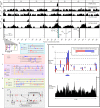Chromosome-scale genome assembly provides insights into rye biology, evolution and agronomic potential
- PMID: 33737754
- PMCID: PMC8035072
- DOI: 10.1038/s41588-021-00807-0
Chromosome-scale genome assembly provides insights into rye biology, evolution and agronomic potential
Abstract
Rye (Secale cereale L.) is an exceptionally climate-resilient cereal crop, used extensively to produce improved wheat varieties via introgressive hybridization and possessing the entire repertoire of genes necessary to enable hybrid breeding. Rye is allogamous and only recently domesticated, thus giving cultivated ryes access to a diverse and exploitable wild gene pool. To further enhance the agronomic potential of rye, we produced a chromosome-scale annotated assembly of the 7.9-gigabase rye genome and extensively validated its quality by using a suite of molecular genetic resources. We demonstrate applications of this resource with a broad range of investigations. We present findings on cultivated rye's incomplete genetic isolation from wild relatives, mechanisms of genome structural evolution, pathogen resistance, low-temperature tolerance, fertility control systems for hybrid breeding and the yield benefits of rye-wheat introgressions.
Conflict of interest statement
V.K. is an employee of KWS SAAT SE & Co. KGaA. D.S. is an employee of HYBRO Saatzucht GmbH & Co. KG. All other authors declare no competing interests.
Figures





References
-
- Lukaszewski, A.J. in Alien Introgression in Wheat (eds Molnár-Láng, M. et al.) 163–189 (Springer, 2015).
-
- Kim W, Johnson J, Baenziger P, Lukaszewski A, Gaines C. Agronomic effect of wheat–rye translocation carrying rye chromatin (1R) from different sources. Crop Sci. 2004;44:1254–1258.
Publication types
MeSH terms
Substances
Grants and funding
LinkOut - more resources
Full Text Sources
Other Literature Sources

